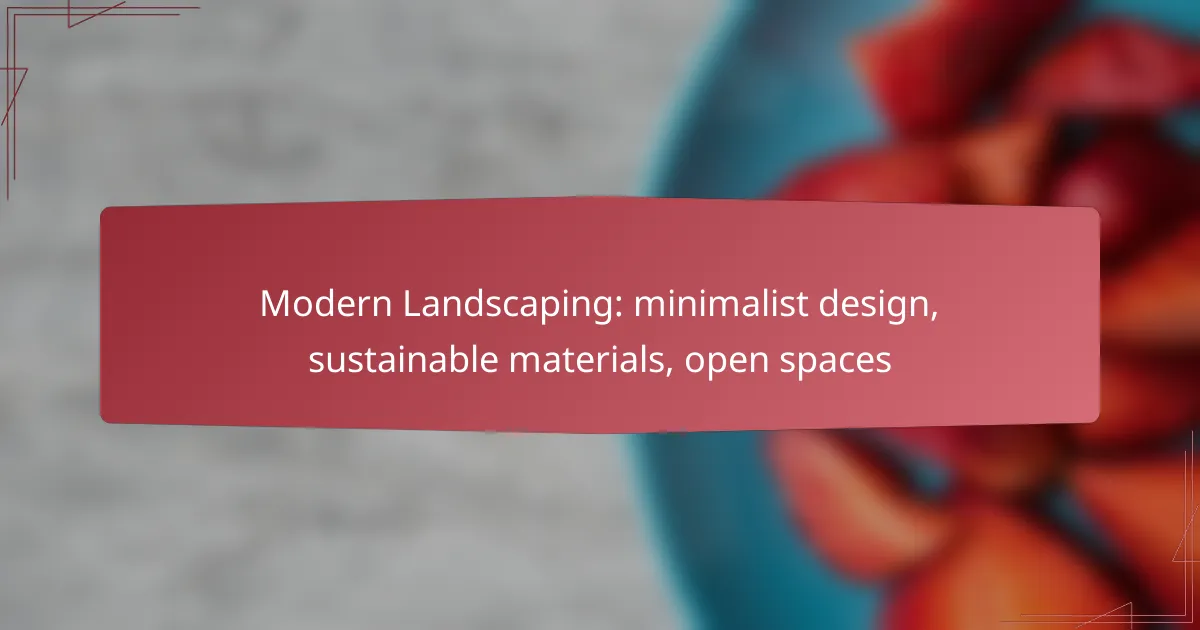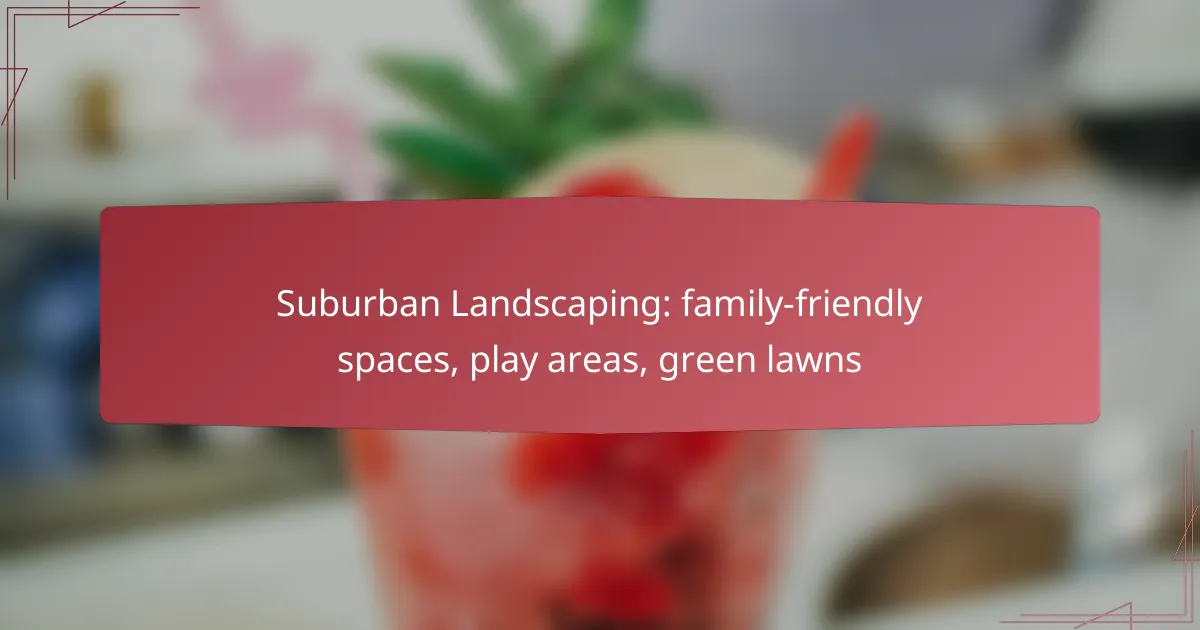Modern landscaping redefines outdoor spaces by embracing minimalist design, sustainable materials, and open areas that promote harmony with nature. This approach not only enhances the visual appeal of a property but also prioritizes environmental responsibility, allowing homeowners to create inviting retreats that reflect contemporary values. By focusing on essential elements and utilizing eco-friendly materials, modern landscaping fosters a seamless connection between indoor and outdoor living.
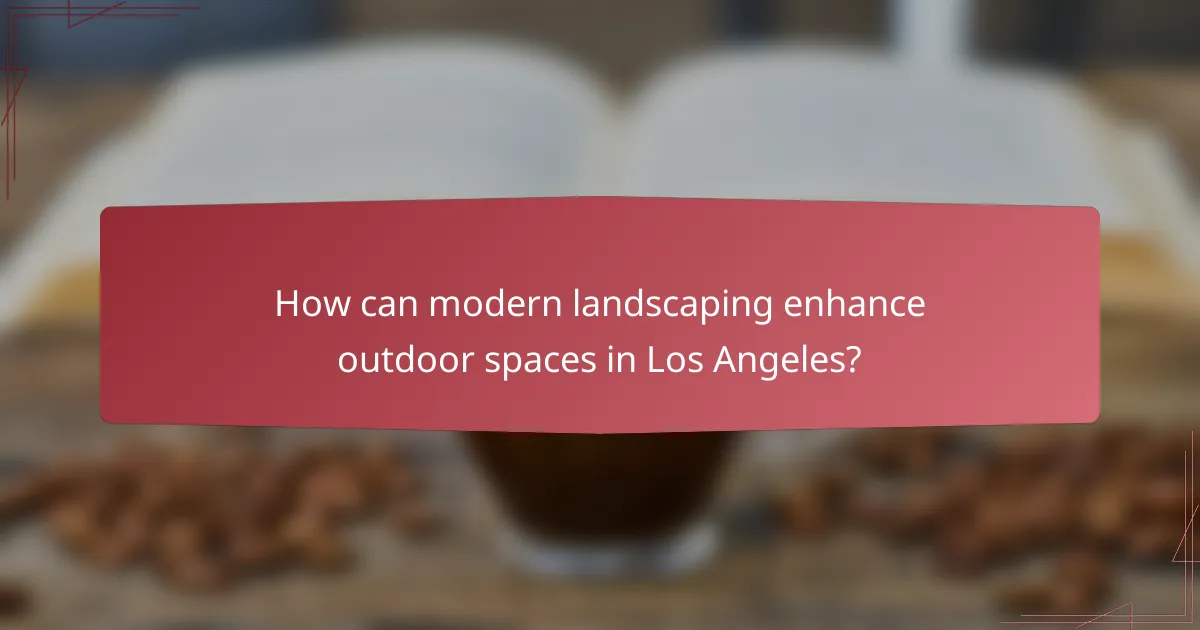
How can modern landscaping enhance outdoor spaces in Los Angeles?
Modern landscaping can significantly enhance outdoor spaces in Los Angeles by creating visually appealing, functional, and sustainable environments. By focusing on minimalist design, sustainable materials, and open spaces, homeowners can transform their yards into inviting retreats that reflect contemporary aesthetics and environmental responsibility.
Increased aesthetic appeal
Modern landscaping emphasizes clean lines, simplicity, and the use of natural materials, which can greatly enhance the visual appeal of outdoor spaces. In Los Angeles, incorporating elements like drought-resistant plants, stone pathways, and minimalist furniture creates a cohesive look that blends with the urban environment.
Consider using a limited color palette and geometric shapes to maintain a modern aesthetic. Features such as water elements or fire pits can serve as focal points, adding both beauty and functionality to the landscape.
Improved functionality
Functional outdoor spaces are essential for maximizing usability in Los Angeles’ climate. Modern landscaping designs often prioritize open spaces that can accommodate various activities, from entertaining guests to relaxing with family.
Incorporating multi-functional furniture and shaded areas can enhance comfort and usability. For instance, a patio with built-in seating and a pergola not only looks stylish but also provides a comfortable area for gatherings while protecting against the sun.
Enhanced property value
Investing in modern landscaping can significantly increase property value in Los Angeles. Well-designed outdoor spaces are attractive to potential buyers, making homes more desirable in a competitive market.
Research indicates that quality landscaping can yield a return on investment of around 15% to 20% when selling a home. Features like sustainable gardens and efficient irrigation systems appeal to eco-conscious buyers, further enhancing marketability.

What are the key principles of minimalist landscaping?
Minimalist landscaping emphasizes simplicity, functionality, and a strong connection to nature. The key principles involve focusing on essential elements, utilizing negative space, and integrating the landscape with its natural surroundings.
Focus on simplicity
Simplicity in landscaping means selecting a limited number of plants and materials to create a cohesive look. This approach avoids clutter and allows each element to stand out, making maintenance easier and enhancing visual appeal.
To achieve simplicity, consider using a monochromatic color palette or a few complementary colors. Aim for clean lines and geometric shapes in hardscaping, which can help create a tranquil environment.
Use of negative space
Negative space refers to the areas around and between objects in a landscape. By intentionally leaving open spaces, you can create a sense of balance and highlight the beauty of the plants and features you do include.
Incorporate negative space by arranging plants with sufficient gaps between them, allowing for air circulation and visual clarity. This technique can also enhance the perception of size in smaller gardens, making them feel more expansive.
Integration with nature
Integrating landscaping with the surrounding natural environment fosters harmony and sustainability. This principle encourages the use of native plants that thrive in local conditions, reducing the need for excessive watering and maintenance.
To effectively integrate with nature, consider using materials that blend with the landscape, such as stone or wood. Creating natural pathways and incorporating water features can also enhance the connection between your garden and its environment.
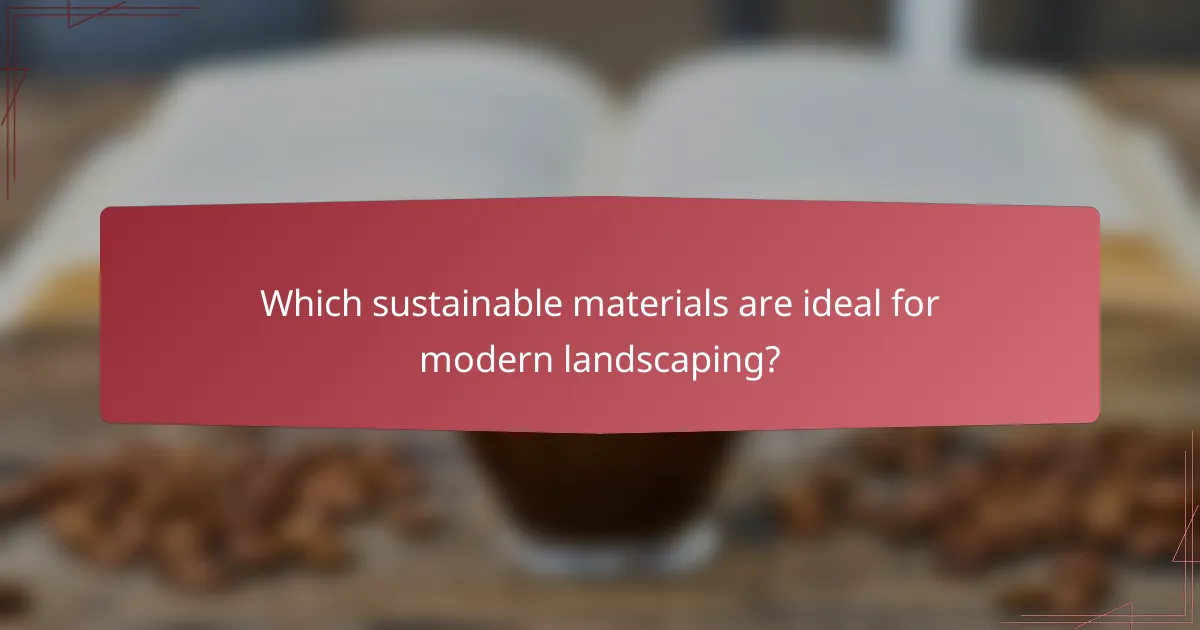
Which sustainable materials are ideal for modern landscaping?
Ideal sustainable materials for modern landscaping include recycled materials, native plants, and permeable paving. These options not only reduce environmental impact but also enhance the aesthetic and functionality of outdoor spaces.
Recycled materials
Recycled materials, such as reclaimed wood, recycled metal, and repurposed bricks, are excellent choices for modern landscaping. They minimize waste and often provide unique character to designs. When selecting recycled materials, consider their durability and maintenance needs to ensure long-lasting use.
For example, using reclaimed wood for garden beds or fencing can add a rustic charm while being eco-friendly. Look for local suppliers to reduce transportation emissions and support community businesses.
Native plants
Native plants are well-suited for modern landscaping because they thrive in local conditions and require less water and maintenance. By choosing plants that are indigenous to your area, you can create a sustainable garden that supports local wildlife and ecosystems.
Consider incorporating a variety of native species to enhance biodiversity. For instance, in the United States, plants like coneflowers and black-eyed Susans are popular choices that attract pollinators while being low-maintenance.
Permeable paving
Permeable paving allows water to pass through surfaces, reducing runoff and promoting groundwater recharge. This sustainable option is ideal for driveways, patios, and walkways, as it helps manage stormwater and prevent erosion.
When selecting permeable materials, options like porous concrete, permeable pavers, or gravel can be effective. Ensure proper installation to maintain functionality and consider local regulations regarding stormwater management to comply with environmental standards.
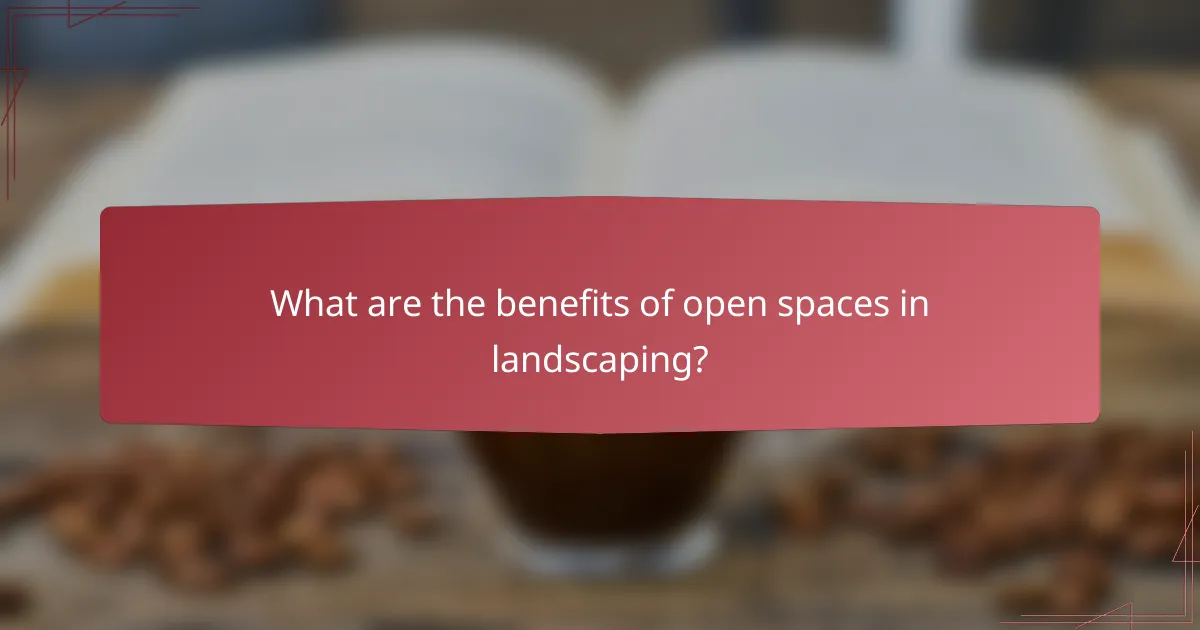
What are the benefits of open spaces in landscaping?
Open spaces in landscaping provide numerous benefits, enhancing both the aesthetic appeal and functionality of outdoor areas. They create environments that foster community interaction, promote relaxation, and contribute to better air quality.
Encourages social interaction
Open spaces facilitate gatherings and social activities, making them ideal for community events or casual meet-ups. Parks, gardens, and plazas designed with ample open areas encourage people to come together, fostering a sense of belonging and community spirit.
To maximize social interaction, consider incorporating seating areas, picnic spots, and pathways that invite movement and conversation. Well-placed features like benches or tables can create inviting spaces for groups to congregate.
Promotes relaxation
Open spaces offer a tranquil environment, allowing individuals to unwind and escape the hustle of daily life. Natural elements such as greenery, water features, and open skies contribute to a calming atmosphere that promotes mental well-being.
When designing for relaxation, prioritize comfortable seating and shaded areas. Incorporating elements like soft landscaping and gentle sounds from water can enhance the soothing experience, making these spaces more appealing for leisure activities.
Improves air quality
Open spaces play a crucial role in enhancing air quality by providing areas for plants to thrive, which in turn produce oxygen and absorb pollutants. Trees and vegetation act as natural filters, reducing harmful emissions and improving overall environmental health.
To maximize air quality benefits, select native plants that are well-suited to the local climate and require minimal maintenance. Incorporating a variety of plant species can create a balanced ecosystem that supports biodiversity while enhancing the air quality in the area.

How to choose the right plants for minimalist landscaping?
Choosing the right plants for minimalist landscaping involves selecting species that align with a clean aesthetic while promoting sustainability. Focus on plants that require minimal maintenance and are well-suited to your local climate to create a harmonious outdoor space.
Consider climate adaptability
Climate adaptability is crucial when selecting plants for minimalist landscaping. Choose species that thrive in your local environment, taking into account factors such as temperature, rainfall, and soil type. Native plants often perform best, as they are naturally suited to the local conditions.
For example, in a temperate climate, consider plants like ornamental grasses or drought-resistant succulents. In warmer regions, look for heat-tolerant varieties that can withstand dry spells without extensive watering.
Focus on low-maintenance options
Low-maintenance plants are ideal for minimalist landscaping, as they reduce the need for frequent care and upkeep. Select perennials that require minimal watering and pruning, allowing you to enjoy your space without constant attention.
Examples of low-maintenance plants include lavender, sedum, and various types of ferns. These plants not only enhance the aesthetic but also contribute to a sustainable landscape by minimizing resource use.
Select for seasonal interest
Incorporating plants that offer seasonal interest can enhance the visual appeal of a minimalist landscape throughout the year. Choose a mix of species that bloom at different times or have varying foliage colors and textures.
For instance, you might combine spring-blooming bulbs with summer-flowering perennials and fall-colored shrubs. This approach ensures your landscape remains dynamic and engaging, even with a limited plant palette.
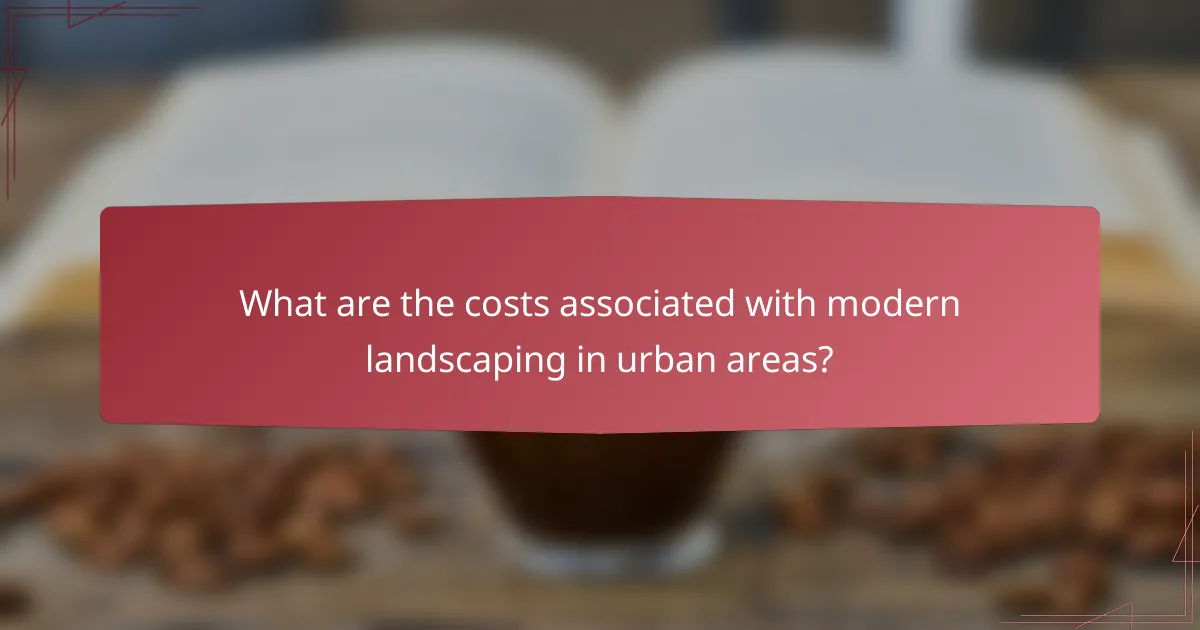
What are the costs associated with modern landscaping in urban areas?
The costs of modern landscaping in urban areas can vary widely based on design complexity, materials used, and local labor rates. Generally, homeowners can expect to invest anywhere from a few thousand to tens of thousands of dollars depending on their specific needs and preferences.
Initial Design and Planning Costs
Initial design and planning costs typically include hiring a landscape architect or designer, which can range from a few hundred to several thousand dollars. This phase is crucial as it sets the foundation for the entire project, ensuring that the design aligns with both aesthetic desires and functional requirements.
Considerations during this phase should include site analysis, zoning regulations, and any necessary permits. Engaging professionals early can help avoid costly mistakes later on.
Material Costs
Material costs for modern landscaping can vary significantly based on the choice of sustainable materials, such as recycled stone, native plants, and permeable paving. Budgeting for materials can range from a few dollars per square foot for basic options to over a hundred dollars for premium, eco-friendly choices.
When selecting materials, prioritize durability and sustainability to minimize long-term maintenance costs. Local suppliers may offer discounts for bulk purchases or eco-friendly options, so it’s worth exploring these avenues.
Labor Costs
Labor costs in urban areas can be substantial, often accounting for a significant portion of the overall landscaping budget. Rates can vary widely, typically ranging from $50 to $150 per hour depending on the complexity of the work and the expertise of the laborers.
To manage labor costs effectively, consider scheduling work during off-peak seasons or bundling services to negotiate better rates. Always obtain multiple quotes to ensure competitive pricing.
Maintenance Costs
Maintenance costs for modern landscaping can also add up, particularly for designs that incorporate extensive planting or specialized features. Annual maintenance can range from a few hundred to several thousand dollars, depending on the size of the space and the complexity of the landscape.
To keep maintenance costs manageable, opt for low-maintenance plants and efficient irrigation systems. Regular upkeep can prevent larger expenses down the line, so establishing a maintenance plan is advisable.
